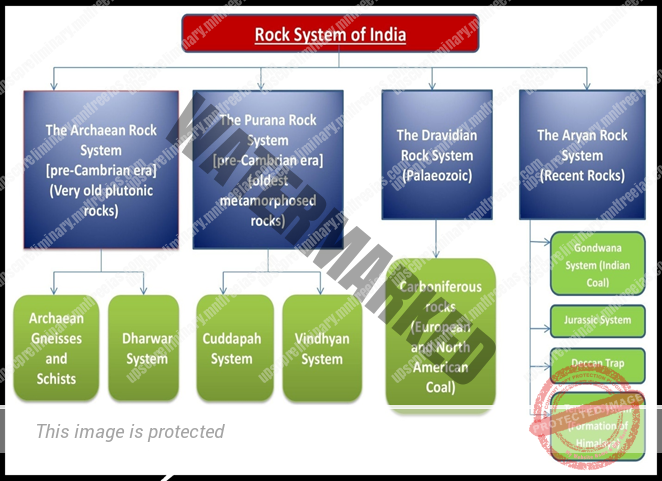- ROCK SYSTEM IN INDIA
UNIT 6 – MINERALS AND RESOURCES – PART 1
MINERALS AND RESOURCES
ROCK SYSTEM IN INDIA
Rock system based on geological history of India
- The Archaean Rock System.
- The Purana Rock System.
- The Dravidian Rock System.
- The Aryan Rock System.
- Archaean rock system
These Rocks are formed prior to the Cambrian system. These are also said to be called very old plutonic rocks. The archean rock system includes
Archaean gneisses and schists and Dharwar system.
- Archaean gneisses and schists
The mineral composition of gneiss varies from granite to gabbro and schists consists mainly of crystalline and include MICA, TALC, HORNBLENDE, CHLORITE, etc.
These rocks were the oldest rocks formed in pre-Cambrian era. i.e., formed about 4 billion years ago.
These rocks were formed due to solidification of molten magma and also known as the basement complex. The term basement complex refers these are the oldest and forms the base for the new layers. These rocks are azoic or unfossiliferous, foliated, crystalline because they are volcanic in origin. These are volcanic rocks found deep inside (plutonic intrusions).
- Dharwar system
The dharwar system formation period ranges from 4 bn years to 1 bn years ago. These rocks are highly metamorphosed sedimentary rock system formed due to metamorphosis of sediment of archean gneisses and schists. These are the oldest metamorphosed rocks found abundantly in the dharwar district of Karnataka.
Economically the most important rocks because they possess valuable minerals like high grade iron-ore, MANGANESE, COPPER, LEAD, GOLD, ETC. THE DHARWAR CRATON LIES ROUGHLY BETWEEN CHENNAI, GOA, HYDERABAD, AND MANGALORE IN THE KARNATAKA AND ANDHRA PRADESH STATES.
- Purana rock system
These are the oldest metamorphosed rock system which includes the Cuddapah System and the Vindhyan System.
- Cuddapah system
These rocks, consists of Unfossiliferous clay, slates, sandstones and limestones, was deposited in synclinal basins. These rocks are best observed in Cuddapah district of Andhra Pradesh. These rocks contain ores of IRON, MANGANESE, COPPER, COBALT, NICKEL, ETC.THEY CONTAIN LARGE DEPOSITS OF CEMENT GRADE LIMESTONE.
- Vindhyan system
This system derives its name from the great Vindhyan mountains. The system comprises of ancient sedimentary rocks (4000 m thick) superimposed on the Archaean base. Mostly Unfossiliferous with large area of this belt is covered by the Deccan trap.
The Vindhyan system have diamond bearing regions from which Panna and Golconda diamonds have been mined. It is devoid of metalliferous minerals but provides large quantities of DURABLE STONES, ORNAMENTAL STONES, LIMESTONE, PURE GLASS MAKING SAND etc.
3) Dravidian rock system
These types were Formed about 600 – 300 million years ago. It is Found in the Extra Peninsular region (Himalayas and Ganga plain) and are very rare in Peninsular India. In this type fossils are abundant in nature. The rocks of Cambrian, Ordovician, Silurian, Devonian and Carboniferous periods are fall under Dravidian system.
- Carboniferous rocks
The Carboniferous rocks comprise mainly of limestone, shale and quartzite. Mount Everest is composed of Upper Carboniferous limestone. The Coal formation started in the Carboniferous age. Carboniferous in geology means coal bearing. Most of the coal found in India is not of Carboniferous period; High quality coal of Great Lakes Region-USA, U.K and Ruhr region is Carboniferous coal.
4) Aryan rock system
These are the recent rocks. It includes Gondwana system, Jurassic system, Deccan trap and Tertiary system.
- The Gondwana system
The Gondwana System [derives its name Gonds, the most primitive people of Telangana and Andhra Pradesh]. They are deposits laid down in synclinal troughs on ancient plateau surface. As the sediments accumulated, the loaded troughs subsided. Fresh water and sediments accumulated in these trough and terrestrial plants and animals thrived.
Gondwana rocks contain nearly 98 per cent of India’s coal reserves. Gondwana coal is much younger than the Carboniferous coal and hence its carbon content is low. They have rich deposits of Iron Ore, Copper, Uranium and Antimony. Sandstones, Slates and Conglomerates are used as building materials.
- Jurassic system
This period witnessed marine transgressions on both west and east coasts. This led to shallow water deposits in Rajasthan and the Kutchch region on the west and Guntur and Rajahmundry areas of Andhra Pradesh. Prominent deposits in this rock system include limestone, shale, sandstone etc.
- Deccan trap
Volcanic outburst over a vast area of the Peninsular India from the end of the Cretaceous till the beginning of the Eocene gave rise to Deccan Traps. Basaltic lava flowed out of fissures covering a vast area of about ten lakh sq km.
These volcanic deposits have flat top and steep sides and therefore called ‘trap’ meaning a ‘stair’ or ‘step’ in Swedish. The process of weathering and erosion (denudation) since millions of years has reduced the Deccan Trap to almost half of its original size.
Present Deccan Trap covers about 5 lakh sq km mainly in parts of Kuchchh, Saurashtra, Maharashtra, the Malwa plateau and northern Karnataka.
Thickness of the Deccan Traps is 3,000 metres along the west which is reduced to 600-800 metres towards the south, 800 metres in Kuchchh and only 150 metres at the eastern limit. The weathering of these rocks for a long time has given birth to black cotton soil known as ‘regur’.
- Tertiary system
These were the period of Eocene to Pliocene about 60 to 7 million years ago. The tertiary is the most significant period in India’s geological history because the Himalayas were born, and India’s present form came into being in this period.

